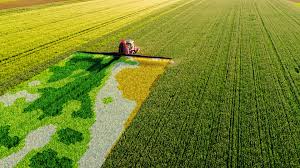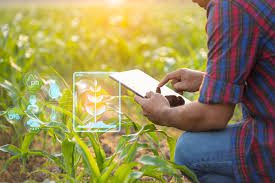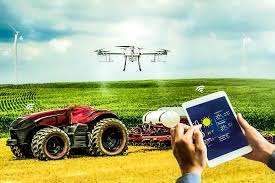Technology plays a crucial role in modern agriculture, helping farmers increase efficiency, productivity, and sustainability. This article explores the introduction of technology in agriculture, its historical development, the benefits of precision agriculture, the impact of drones, and the significance of smart irrigation systems.
Technology in Agriculture encompasses various tools, techniques, and processes designed to improve farming practices. By integrating technology into agriculture, farmers can optimize resources, enhance crop yields, and reduce environmental impacts.
Understanding the evolution and application of agricultural technology is vital for addressing the challenges of modern farming.
Historical Overview of Agricultural Technology
Agricultural technology has a rich history, evolving from simple tools to advanced systems. Here’s a brief overview:
1. Traditional Tools: Early farmers used basic tools like plows, sickles, and hoes, relying on manual labor to cultivate crops.
2. Mechanization: The Industrial Revolution introduced machinery such as tractors and harvesters, significantly increasing productivity and reducing labor requirements.
3. Chemical Innovations: The development of synthetic fertilizers and pesticides in the 20th century enhanced crop yields but raised concerns about environmental impacts.
4. Biotechnology: Advances in genetic engineering and biotechnology have enabled the development of improved crop varieties with enhanced traits, such as disease resistance and drought tolerance.
5. Digital Technology: The rise of computers and the internet has led to the integration of digital tools in agriculture, facilitating data collection and analysis for better decision-making.
Precision Agriculture: Enhancing Efficiency and Productivity

1. Data-Driven Decision Making: By using sensors, satellite imagery, and soil data, farmers can make informed decisions about planting, fertilizing, and irrigating.
2. Resource Optimization: Precision agriculture enables farmers to apply inputs, such as water and fertilizers, only where needed, reducing waste and costs.
3. Improved Crop Yields: Targeted interventions based on data analysis can lead to higher crop yields and better quality produce.
4. Environmental Sustainability: By minimizing chemical use and optimizing resource allocation, precision agriculture helps reduce the environmental footprint of farming.
5. Increased Profitability: Enhanced efficiency and productivity can lead to higher profits for farmers, making their operations more economically viable.
The Impact of Drones in Modern Farming
Drones have revolutionized modern farming practices by providing aerial data and insights. Here are some key impacts:
1. Crop Monitoring: Drones can capture high-resolution images of fields, allowing farmers to assess crop health and identify problem areas quickly.
2. Precision Spraying: Equipped with spraying systems, drones can apply fertilizers and pesticides precisely, reducing chemical use and minimizing environmental impact.
3. Soil Analysis: Drones can collect data on soil conditions, helping farmers understand nutrient levels and moisture content for better management.
4. Efficient Mapping: Aerial surveys conducted by drones can create detailed maps of fields, aiding in planning and management.
5. Cost-Effective Solutions: Drones are often more affordable than traditional methods of data collection, making advanced technology accessible to small and medium-sized farms.
Smart Irrigation Systems: Conserving Water Resources
Water scarcity is a significant challenge in agriculture, making smart irrigation systems essential. Here are some features and benefits:
1. Automated Irrigation: Smart systems use sensors to monitor soil moisture levels and automatically adjust water delivery, ensuring crops receive the right amount of water.
2. Water Conservation: By applying water only when needed, smart irrigation systems help conserve water resources and reduce costs for farmers.
3. Improved Crop Health: Consistent and appropriate watering promotes healthier plants, leading to better yields and quality.
4. Remote Monitoring: Farmers can monitor irrigation systems remotely through mobile applications, allowing for timely adjustments and management.
5. Integration with Weather Data: Smart irrigation systems can integrate weather forecasts to optimize watering schedules, further enhancing efficiency.
Here’s the article on The Role of Technology in Advancing Agriculture structured with clear headings and bolded list numbers for easy readability.
Read Also: 5 Amazing Health Benefits of Triphala (Three fruits)
The Use of Artificial Intelligence in Crop Management

Artificial intelligence (AI) is transforming crop management by enabling data-driven decisions and improving efficiency. Here are some key applications:
1. Predictive Analytics: AI can analyze historical data to predict crop yields, pest outbreaks, and disease risks, helping farmers make informed decisions.
2. Precision Farming: AI-powered tools can assess soil conditions, monitor crop health, and recommend optimal planting and harvesting times.
3. Automation of Routine Tasks: AI can automate repetitive tasks like planting and irrigation, reducing labor costs and increasing efficiency.
4. Decision Support Systems: AI algorithms can provide farmers with actionable insights, enhancing their ability to manage resources effectively.
5. Personalized Recommendations: AI can offer tailored solutions based on specific farm conditions, improving productivity and sustainability.
Biotechnology: Advancements in Crop Yield and Resistance
Biotechnology has revolutionized crop production by developing genetically modified organisms (GMOs) that enhance yield and resistance. Here’s how:
1. Disease Resistance: Biotech crops can be engineered to resist pests and diseases, reducing the need for chemical pesticides and improving crop survival.
2. Drought Tolerance: Genetic modifications can enhance a plant’s ability to withstand drought conditions, ensuring food production in challenging climates.
3. Nutritional Enhancement: Biotechnology can be used to fortify crops with essential vitamins and minerals, addressing nutritional deficiencies in populations.
4. Increased Yield: Biotech crops often have higher yields compared to conventional varieties, contributing to food security.
5. Reduced Environmental Impact: By reducing the need for chemical inputs, biotech crops can lower the environmental footprint of agriculture.
Mobile Applications for Farmers: Access to Information
Mobile applications are providing farmers with instant access to information and resources. Here are some benefits:
1. Real-Time Weather Updates: Farmers can receive weather forecasts and alerts, allowing them to plan their activities more effectively.
2. Market Information: Mobile apps can provide price updates and market trends, helping farmers make informed decisions about selling their produce.
3. Best Practices: Farmers can access educational content, including tips on sustainable farming practices, pest management, and crop care.
4. Financial Management: Many apps offer tools for budgeting, expense tracking, and financial planning, helping farmers manage their operations efficiently.
5. Community Support: Mobile platforms can connect farmers with local communities and experts, fostering collaboration and knowledge sharing.
The Role of Robotics in Agriculture
Robotics is increasingly being used in agriculture to automate various tasks. Here are some key roles of robotics:
1. Harvesting Automation: Robotic systems can harvest crops with precision, reducing labor costs and improving efficiency.
2. Weeding and Pest Control: Robots equipped with sensors can identify and remove weeds or apply targeted treatments for pests, minimizing chemical use.
3. Soil Preparation: Robotics can automate soil tilling and planting processes, ensuring optimal planting conditions.
4. Monitoring and Surveillance: Drones and ground-based robots can monitor crop health, soil conditions, and irrigation needs, providing valuable data for management.
5. Labor Shortage Solutions: Robotics can help address labor shortages in agriculture, ensuring that essential tasks are completed efficiently.
Sustainable Farming Practices through Technology
Technology is driving the adoption of sustainable farming practices, ensuring long-term agricultural viability. Here are some examples:
1. Integrated Pest Management (IPM): Technology helps farmers implement IPM strategies, combining biological, cultural, and chemical methods to manage pests sustainably.
2. Resource Conservation: Technologies like drip irrigation and rainwater harvesting systems enable farmers to conserve water and optimize its use.
3. Precision Fertilization: Using technology to apply fertilizers based on soil nutrient levels reduces waste and minimizes environmental impact.
4. Carbon Farming: Technologies that promote carbon sequestration in soils can help mitigate climate change while enhancing soil health.
5. Circular Agriculture: Innovative practices, such as recycling organic waste and using cover crops, promote sustainability and reduce dependency on external inputs.
Read Also: The Effect of Solid Waste on Business Environments
Data Analytics: Making Informed Agricultural Decisions

Data analytics is transforming the way farmers make decisions by turning raw data into actionable insights. Here are some key aspects of data analytics in agriculture:
1. Yield Prediction: Analyzing historical yield data helps farmers predict future yields, enabling better planning and resource allocation.
2. Soil Analysis: Data analytics can assess soil health and nutrient levels, guiding farmers in selecting appropriate fertilizers and amendments.
3. Pest and Disease Management: Analyzing patterns in pest and disease outbreaks allows farmers to implement preventive measures, reducing losses.
4. Weather Forecasting: Access to accurate weather data enables farmers to make timely decisions about planting, irrigation, and harvesting.
5. Financial Analysis: Data analytics helps farmers evaluate their financial performance, identify cost-saving opportunities, and improve profitability.
E-commerce and Market Access for Farmers
E-commerce platforms are changing the way farmers connect with consumers, providing new market opportunities. Here’s how e-commerce benefits farmers:
1. Direct Sales: Farmers can sell their products directly to consumers, eliminating middlemen and increasing profit margins.
2. Expanded Reach: E-commerce allows farmers to reach a broader audience, including urban markets and international buyers.
3. Consumer Insights: Online platforms provide valuable data on consumer preferences and trends, helping farmers tailor their products accordingly.
4. Reduced Marketing Costs: E-commerce reduces the need for traditional advertising, allowing farmers to promote their products at a lower cost.
5. Access to Resources: Many e-commerce platforms offer educational resources and tools that empower farmers with knowledge about market trends and best practices.
Challenges of Implementing Technology in Agriculture
While technology offers significant benefits, farmers face several challenges in its implementation. Here are some key obstacles:
1. High Initial Costs: The investment required for new technologies can be a barrier, especially for smallholder farmers with limited financial resources.
2. Lack of Technical Knowledge: Many farmers may lack the skills or training needed to effectively use advanced technologies, limiting their adoption.
3. Infrastructure Limitations: Poor infrastructure, including limited internet access in rural areas, can hinder the successful implementation of technology.
4. Resistance to Change: Some farmers may be resistant to adopting new methods or technologies due to tradition or skepticism about their effectiveness.
5. Data Privacy Concerns: With increased data collection comes concerns about data privacy and ownership, which can deter farmers from fully embracing technology.
Do you have any questions, suggestions, or contributions? If so, please feel free to use the comment box below to share your thoughts. We also encourage you to kindly share this information with others who might benefit from it. Since we can’t reach everyone at once, we truly appreciate your help in spreading the word. Thank you so much for your support and for sharing!
Read Also: How Guava Fruits and Leaves Improve Female Fertility

